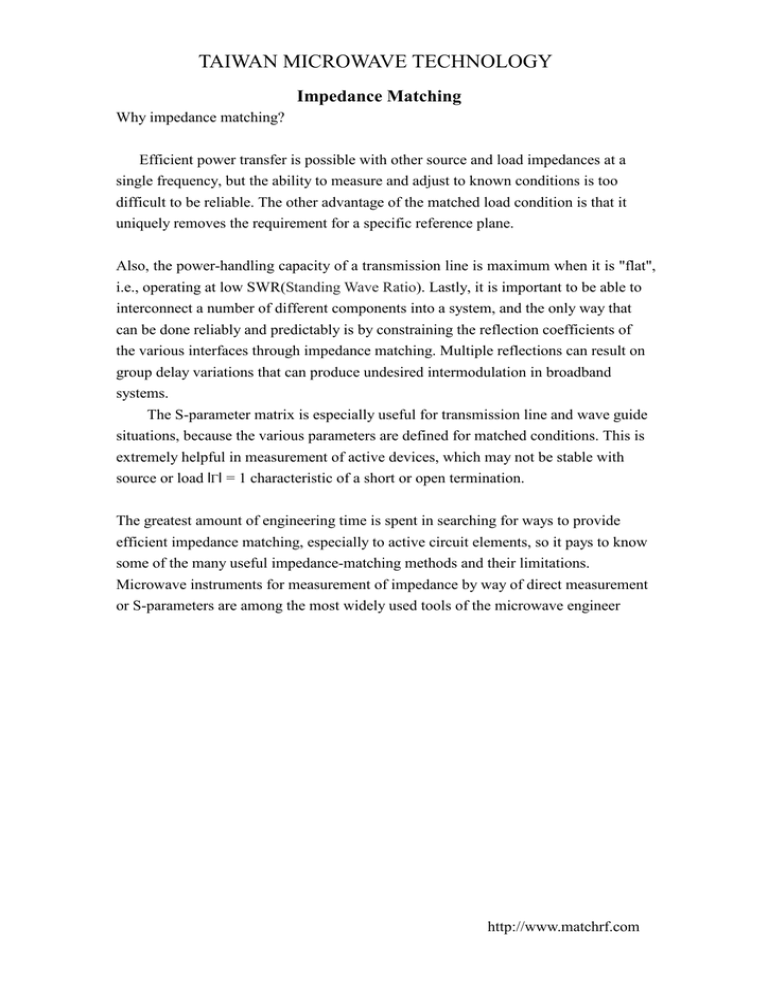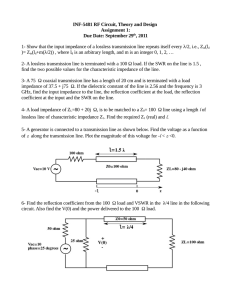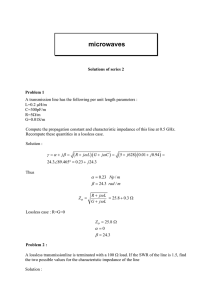Impedance Matching
advertisement

TAIWAN MICROWAVE TECHNOLOGY Impedance Matching Why impedance matching? Efficient power transfer is possible with other source and load impedances at a single frequency, but the ability to measure and adjust to known conditions is too difficult to be reliable. The other advantage of the matched load condition is that it uniquely removes the requirement for a specific reference plane. Also, the power-handling capacity of a transmission line is maximum when it is "flat", i.e., operating at low SWR(Standing Wave Ratio). Lastly, it is important to be able to interconnect a number of different components into a system, and the only way that can be done reliably and predictably is by constraining the reflection coefficients of the various interfaces through impedance matching. Multiple reflections can result on group delay variations that can produce undesired intermodulation in broadband systems. The S-parameter matrix is especially useful for transmission line and wave guide situations, because the various parameters are defined for matched conditions. This is extremely helpful in measurement of active devices, which may not be stable with source or load lΓl = 1 characteristic of a short or open termination. The greatest amount of engineering time is spent in searching for ways to provide efficient impedance matching, especially to active circuit elements, so it pays to know some of the many useful impedance-matching methods and their limitations. Microwave instruments for measurement of impedance by way of direct measurement or S-parameters are among the most widely used tools of the microwave engineer http://www.matchrf.com TAIWAN MICROWAVE TECHNOLOGY What Constitutes a Good Match? In many situations, a good match is defined arbitrarily as having SWR<1.5. Recall that SWR = 1+ lΓl / 1+lΓl So lΓl = SWR-1/SWR+1 , and since the reflected power is lΓl2, we can express the so-called Return Loss as RL = -10 log lΓl2 = -20 log lΓl dB and the transmitted power to the load, relative to the incident wave power, is TL = -10 log (1 - lΓl2) dB From this table, one can see that the reflected power from the mismatch becomes of 1.5, although in many the same order of magnitude as the incident power at SWR situations we require return loss greater than 30 dB, which corresponds to SWR = 1.07, a real challenge over any bandwidth. SWR lΓl 1.0 0.00 1.05 0.02 1.1 Return loss dB > 35 1-lΓl2 Transmitted loss dB 1.00 0.00 32.3 1.00 0.00 0.05 26.4 1.00 0.01 1.2 0.09 20.8 0.99 0.04 1.5 0.20 14.0 0.96 0.18 2.0 0.33 9.5 0.86 0.50 Typical Matching Situations It's relatively easy to design resistive terminations for waveguide and TEM structures that provide extremely wideband loads with Z=ZO of the transmission line. For situations where the loads must dissipate substantial power, thermal considerations come into play, and some form of conductive or convective cooling is necessary to prevent destruction of the load. In the extreme case, a long enough length of terminated lossy transmission line will present a high-power matched load to a transmission line of the same dimensions. The going gets tough in cases where impedance matching is required to narrow-band elements such as antennas or to devices with substantial reactance and resistance levels that are much lower (or higher) than typical transmission lines. An arbitrary impedance can, in principle, be matched at a single frequency by adding sufficient transmission line to move the impedance around the Smith chart until it lies on an admittance circle that passes through the center of the chart (g=20 millimhos or milliSiemens), then adding susceptance of the proper sign to move the combined http://www.matchrf.com TAIWAN MICROWAVE TECHNOLOGY admittance to the Γ=0 point. The simplified Smith charts here show one of the two possible solutions for an arbitrary normalized impedance. The other solution is Although inconvenient to realize in transmission line format, there are two other solutions that are obtained by rotating the arbitrary impedance until it is on the 50_ circle, then adding the proper series reactance to bring the resulting impedance to the 50_ point. Recall that a useful expression for the impedance of a loss less transmission line of characteristic impedance Zo with an arbitrary load ZL and electrical length θ is This can be used in connection with a spreadsheet or other calculation aid to keep track of the real and imaginary parts with varying frequency. But these are single-frequency solutions to the impedance matching problem. Because one of the major advantages of microwave usage is the opportunity to transmit substantial bandwidth, and because in practice one would hope to avoid a requirement for a unique circuit for each of the many frequencies in a typical 40% waveguide band, broadband solutions to the matching problem are valuable and sought-after. http://www.matchrf.com TAIWAN MICROWAVE TECHNOLOGY Lumped LC Networks The transmission-line solutions illustrated above correspond approximately to a simple L network in lumped circuit theory. Depending upon the specific frequency characteristics of the arbitrary impedance to be matched, one of the four approaches listed here will generally provide the greatest bandwidth. The same is true with transmission line matching networks. Series L Shunt C Shunt C Series L Shunt L Series C Series C Shunt L In addition to the problem of matching a purely resistive load that is not equal to ZO, the typical practical problem includes substantial load reactance as well. As we shall see, this limits the bandwidth over which a good match can be achieved. If the load impedance or admittance has a dominant reactive part, this can be included in the element required for the L network so that the maximum bandwidth can be achieved. This technique of "swallowing" the load reactance into the matching structure is a first step toward broader-band matching possibilities. A good example of this technique is used to match antennas whose resistance is less than that of the transmission line, and whose reactance can be set by shortening the length of the radiating element from the resonant length。 Under these circumstances, the antenna resistance is essentially unchanged, but the reactance is capacitive, with the magnitude determined by the offset from resonance. By choosing a resonant frequency above the working frequency such that the conductance of the antenna admittance is equal to the YO of the line, adding a shunt inductor will cancel the reactive part of the antenna admittance and result in a match to the transmission line. The form of the inductor can be lumped or transmission line, and the physical realization of this matching approach is quite simple. The realization of this approach with an open-wire transmission line inductor is known variously as a hairpin or Beta matching network. http://www.matchrf.com TAIWAN MICROWAVE TECHNOLOGY Single and Double Stub Tuners A simple form of variable impedance matching device is the single stub tuner. It consists of a transmission line with a sliding short circuit (similar to a trombone) that can be used as the reactive element in the impedance matching method shown in the Smith charts above. An open circuit, which is difficult to realize, can also be used in this tuner. A limitation of the single stub tuner is that it must be placed at the proper distance from the load, which is a variable that is difficult to adjust in practice. A double stub tuner, illustrated here, partially removes the requirement for variable distance from the load, and is widely used in laboratory practice as a single frequency match device. In actual design practice, it is replaced by more compact and broadband approaches for products that will be manufactured and used in any quantity. A loss less double stub tuner can match to line YO any load whose conductive component at the plane of the closest stub is less than G = YO (1+cot2θ), where θ is the electrical length between the two stubs. This implies that values of θ = n_ (0°, 180°, etc.) are optimum since they will match infinite G, but the losses in a practical tuner defeat this concept. In practice, the stubs are spaced odd multiple of λ/8, which will match any admittance whose conductance is less than G = 2Yo at the plane of the stub nearest the load. By varying the line length between that stub and the load, almost any load can be matched at a single frequency. http://www.matchrf.com TAIWAN MICROWAVE TECHNOLOGY The Bode and Fano Limit There exists a general limit on the bandwidth over which an arbitrarily good impedance match can be obtained in the case of a complex load impedance. It is related to the ratio of reactance to resistance, and to the bandwidth over which we desire to match the load. Bode and Fano derived, for lumped circuits, a fundamental limitation that is expressed for a parallel RC load impedance as Since ln (1) = 0, there is no contribution to this integral over frequencies for which lΓl =1, so we can see that we want to have the maximum mismatch out of the band of interest。If we assume this condition, the integral is limited to the bandwidth of interest △, and we can get an idea of how well we can match an arbitrary complex impedance over that bandwidth. Consider the idealized situation shown in the figure here, where the reflection coefficient is unity outside the band of interest and is Γm in the frequency range△. For this simplification, the integral becomes Recalling that ln (x) = -ln (1/x) and solving for Γm, we have Γm≧e-1/2_fRC This can be solved for the maximum bandwidth for which a given RC product can be matched to within a given reflection coefficient or SWR. There are similar limitations on other forms of complex impedance, but the general nature of the limitation is the important issue. A general implication of the Bode-Fano limit is that one should not waste any match out-of-band, and that the best inband match is obtained with Tchebyscheff rather than maximally flat networks. The best broadband impedance matching practice incorporates the complex load impedance into a multisection filter structure with a design that includes the characteristics of the load. However, it is useful to understand some simpler methods as well. http://www.matchrf.com TAIWAN MICROWAVE TECHNOLOGY Quarter-Wave Transformers Quarter-wave transmission line transformers are a simple, but bulky, method of matching impedances. At band center, a quarter wave transformer has an input impedance that is which is simply the general formula for input impedance with θ =π/2. The bandwidth of such a matching transformer depends upon the ratio of ZL/Zo, which is the load impedance normalized to the desired input impedance. The reflection coefficient is approximately To determine the bandwidth for a given impedance ratio and maximum SWR, solve for θ at each band edge in terms of the band-edge reflection coefficient for that SWR. As an example, for maximum SWR of 1.5 and an impedance ratio of 4, the bandwidth for 1.5 SWR is approximately 34% (±17%). http://www.matchrf.com TAIWAN MICROWAVE TECHNOLOGY Transmission Lines as LC Circuits A more generally useful matching network can be realized by the use of two short sections of transmission line, of differing impedances. For the case of Z02 substantially higher than ZL (say, Z02>3lZLl) and θ2 small compare to a wavelength (θ2<π/6), the higher impedance section can be approximated to a series inductive reactance of Z02 θ2 XL Likewise, if Y01 is large compared with lYLl and θ1 is small compare to a wavelength, the lower impedance section can be approximated by a shunt capacitive susceptance of Y01 θ1 BC Thus short narrow and wide sections of transmission line can be used to approximate the lumped-element L-C networks shown earlier. Reference: 1 See Vendelin, Pavio & Rohde, Microwave Circuit Design Using Linear and Nonlinear Techniques, J. Wiley, 1990, pg. 158-192 2 Rizzi, P. Microwave Engineering - Passive Circuits, Prentice Hall, 1988, pg. 127-132. 3 Montgomery, Dicke & Purcell, Principles of Microwave Circuits, MIT Rad Lab Series #8, 1947, pg. 203-206. 4 Sevick, J., Transmission Line Transformers, 2nd Edition, ARRL, 1990 http://www.matchrf.com


